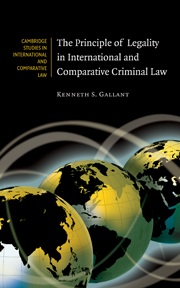Book contents
- Frontmatter
- Contents
- Explanatory Note on Spelling
- Acknowledgments
- Introduction
- 1 Legality in Criminal Law, Its Purposes, and Its Competitors
- 2 A Partial History to World War II
- 3 Nuremberg, Tokyo, and Other Postwar Cases
- 4 Modern Development of International Human Rights Law: Practice Involving Multilateral Treaties and the Universal Declaration of Human Rights
- 5 Modern Comparative Law Development: National Provisions Concerning Legality
- 6 Legality in the Modern International and Internationalized Criminal Courts and in the UN Trust Territories
- 7 Legality in Customary International Law Today
- Conclusion: The Endurance of Legality in National and International Criminal Law
- Appendix A Chart of Non-retroactivity Provisions in Criminal Law by Nations
- Appendix B Legality and Non-retroactivity Provisions as of 1946–47
- Appendix C Constitutional and Other National Provisions Implementing the Principle of Legality Today
- Bibliography
- Table of Authorities
- Index
- Afterword and Update
- CAMBRIDGE STUDIES IN INTERNATIONAL AND COMPARATIVE LAW
- References
2 - A Partial History to World War II
Published online by Cambridge University Press: 04 July 2009
- Frontmatter
- Contents
- Explanatory Note on Spelling
- Acknowledgments
- Introduction
- 1 Legality in Criminal Law, Its Purposes, and Its Competitors
- 2 A Partial History to World War II
- 3 Nuremberg, Tokyo, and Other Postwar Cases
- 4 Modern Development of International Human Rights Law: Practice Involving Multilateral Treaties and the Universal Declaration of Human Rights
- 5 Modern Comparative Law Development: National Provisions Concerning Legality
- 6 Legality in the Modern International and Internationalized Criminal Courts and in the UN Trust Territories
- 7 Legality in Customary International Law Today
- Conclusion: The Endurance of Legality in National and International Criminal Law
- Appendix A Chart of Non-retroactivity Provisions in Criminal Law by Nations
- Appendix B Legality and Non-retroactivity Provisions as of 1946–47
- Appendix C Constitutional and Other National Provisions Implementing the Principle of Legality Today
- Bibliography
- Table of Authorities
- Index
- Afterword and Update
- CAMBRIDGE STUDIES IN INTERNATIONAL AND COMPARATIVE LAW
- References
Summary
The principle of legality has a long and checkered history in Western and other systems of jurisprudence. It appears in some form in many legal systems but also was subject to many exceptions and violations in those systems. For example, various implementations of legality, in both the criminal and non-criminal law, appeared in Justinian's compilations of laws. One of the most famous sections of the Magna Carta guarantees that no free man should be deprived of liberty, property, protection of the laws, or life, except according to law. This has been read by moderns as an embodiment of the principle of legality, in the sense of prohibiting retroactive criminalization or punishment. However, it is unclear whether it would have been understood to mean that the substantive law must have been proclaimed in advance of the criminal act or merely that the procedural law must be obeyed, or something of both. Indeed, as with many provisions of documents or statements of general principle from many ages that we moderns would call “open texture[d],” it is not clear that there would have been consensus at the time, if anyone had asked the question.
OVERVIEW
Civil Law and Common Law
Conventional wisdom, which is often conventional because it has a great deal of support in the evidence, credits the Enlightenment and eighteenth- and nineteenth-century positivism for the growth and spread of the principle of legality into a fundamental element of criminal law in many nations worldwide.
- Type
- Chapter
- Information
- Publisher: Cambridge University PressPrint publication year: 2008

